|
 |
Dancing Dervishers
Konya, Kappadokia, Türkey |
 |
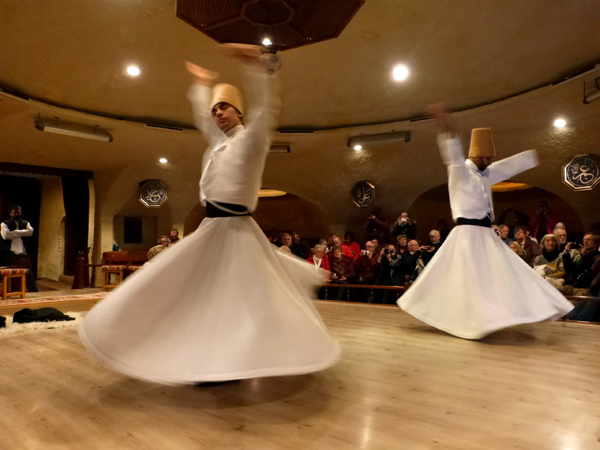
Mevlevi Dervishes, devotees of
Mevlevi Rumi,
in the ecstacy of the whirling dance.
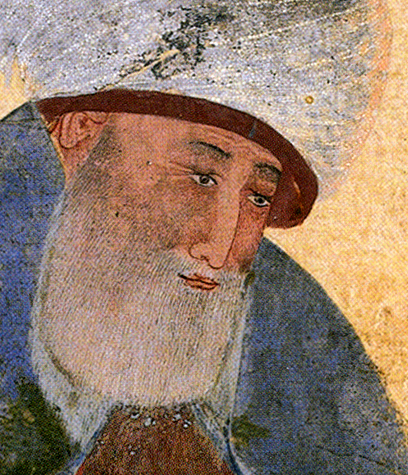
Mevlana Rumi founder of the Sufi Order
|
The Sema - a Sufi
Sacrement |
|
In Sufism, the love of
the Divine requires a reunion with Allah. The actual meaning of the
word Sema or Sama is "to hear", but the term is now used to denote losing
oneself in whirling. Mevlana Rumi,
the founder of the Mevlevi Sufi Order encouraged Sema, that is, listening
to music, turning and doing the sacred dance.
At the time of Mevlana Rumi there were no set procedures of how to
perform this ritual dance. During time it developed into what can be experience today. The Sema arrived at its final state in the
15th century and only minor changes was seen in the 17th century. The Sema dance of the Sufi tadition is
an important part of Türkish selfunderstanding and everywhere in
Türkey you can visit Mevlevi Centers, where the Sema is performed.
The Sema whirling is a
physically active meditation and the spinning of the body symbolize
the planets in the solar system orbiting the sun. The Dervishes or
Semazens focus on God and finally become one with him in this
meditation.
Other spiritual
schools have used the whirling as a means of transcending. In the
early 1970'ies the Indian Master Bhagwan Sree Rashness, later called
Osho incorporated the whirling tecnique in His programs as a
very powerful dynamic meditation tecnique.
|
|
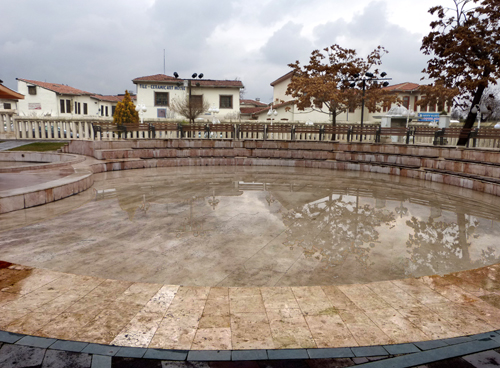
The outdoor Semahane or
dancing place in the Mevlana Museeum, Konya.
The water is due to the rainfall that day.
|
|
Sema, the ritual dance |
|
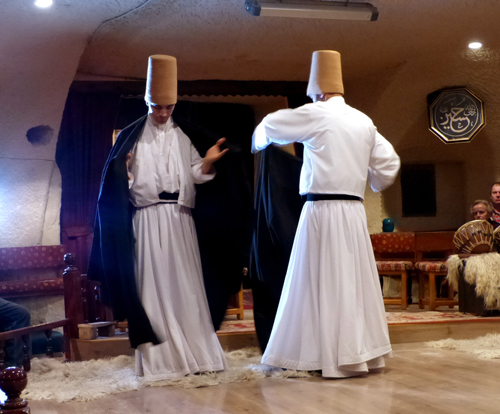
The gown is taken of
entering the Sema dance ground.
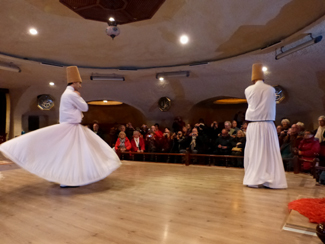 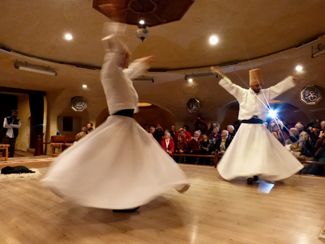
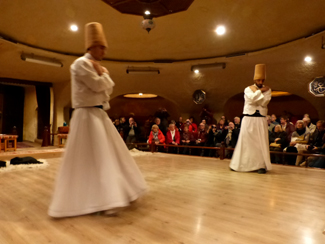 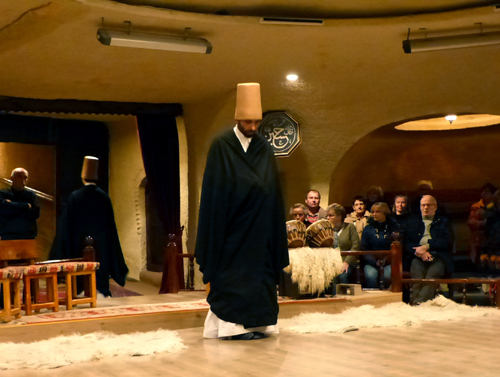
Dressed in
long white gowns, symbolizing the death of the ego and wearing a
high cone shaped felt hat (Sikke), symbolizing the ego's tombstone, the
dervish dances for hours at a time. With arms held high, the right
hand lifted upward to recieve divine blessings and energy from
heaven, the left hand turned downward to bestove these blessings on
earth, the body is spinning from right to left. The dervish revolves
around the heart and embraces all of creation with love. The group
form a circle, each turning in harmony with the rhythm of the
accompanying music. They slowly pick up speed and intensity
untill they reach a spiritual exaltation.
The ritual dance Sema,
is seen from outside, a very formalized group
dance. But the performance is laden with mystic symbolism and
meaning.
|
The
significance of the Sema |
|
The
Sema consists of seven parts, each with specific spiritual
significance.
1. The ceremony starts with an eulogy, "Nat-i serif" to the
Prophet Muhammad, who represents love and all prophets before him.
To praise them is praising God, who created all of them.
2. The eulogy is followed by a drum sound symbolizing the
Divine order of the Creator, "Kun" meaning "Be!"
3. An instrumental music improvisation follows, a "Taksim".
The Taksim is played with a red wind instrument called a "Ney",
which represents the first breath witch gave life to everything, the
Divine Breath.
4. Fourth part is where the dervishes greet each other and
perform their thrice repeated circular walk called the "Devri
Veledi". The music accompanying is called "Peshrev". This part
symbolizes the salutation of soul to soul concealed by shapes and
bodies.
5. Fifth part is the Sema whirling, hich consists of four
salutes or "Selams". At the end of each salute, as in the onset, the
dervish testifies to God's unity with his appearance.
A. First salute is man's birthinti truth through feeling and
the mind. It represents his complete conception of the ecstasy of
God as the creator and his own state of being.
B. Second salute expresses the rapture of man witnessing the
splendour of creation in ront of God's greatness and omnipotense.
C. The third salute is the dissolution of rapture into love
and thereby the sacrifice of the mind to love. It is complete
submission. It is the annihilation of self in the loved one, in His
unity.
This state of Ecstasy is known as "Nirvana" in Buddhism and
"Fenafillah" in Islam. In Buddhism, this is the highest state of
ecstasy. However, the highest rank in Islam is the rank reached by
the Prophet. He is called God's servant and his messenger. The aim
of Sema is not unbroken ecstacy, loss of conscious thought and
realization of submission to God.
D. The fourth salute: Just as the Prophet ascends to the
"Throne" and then returns back to his task on earth, the whirling
dervishes, following the termination of their spiritual journey and
ascent, return to their taks and to their state of subservience. "He
is a servant of God, of His books, of His prophets and all creation
..." At the end of their salute, they demonstrate this again with
their apperance, arms crisscrossed over the chest to represent the
unity of God, conciously and feelingly.
6. The sixt
part of the Sema is reading of the Quoran, especialy of the verse,
"Unto God belong the East and the West, and whereever you turn,
there is God's countenance. "He is All-Embracing, All-Knowing".
7. The Sema
ceremony ends with a prayer for peace of the souls of all Prophets
and all believers. After the completion of the Sema ceremony, all
the dervishes return silently to their cells for meditation,
"Tefekkür". |

The Mevlevi bow in gratitude and exaltation at the end of the
ritual.
"Not Christian, Muslim
or Jew,
not Hindu, Buddhist, Sufi or Zen.
Not any religion or cultural system.
I am not from the East or the West,
not out of the Ocean or up from the Ground,
not Natural or Etheral,
Not Composed of Elements at all.
Mevlana Rumi.
|
|
The Sikke camel hair
hat |
|

A Mevlevi headpece on a seat of red animal hide,
represents the seat of the
Sheik. The camel hair hat,
called "sikke" represents the tombstone of the
ego!
The colour red
on the camel hair carpet symbolizes the sunset at the time Mevlana Rumi died.
The Sikke is always present in the Sema ritual. The Shieks seat is built in the
bannister around the Sema.
|
|
A Sema Center in
Kappadokia |
|
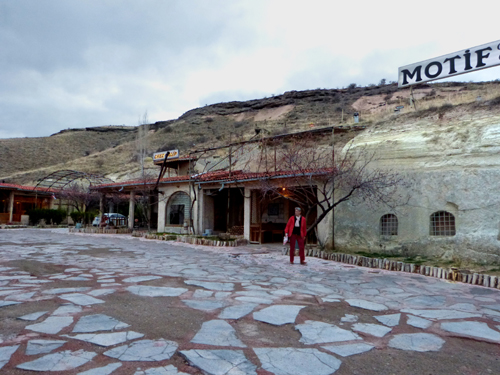
The Motif Culture Center in Nevsehir,
Kappadokia carved into a solid rock.

The dance hall of the
center carved in
the rock.
|
|
Sema, a great tourist
attraction |
|
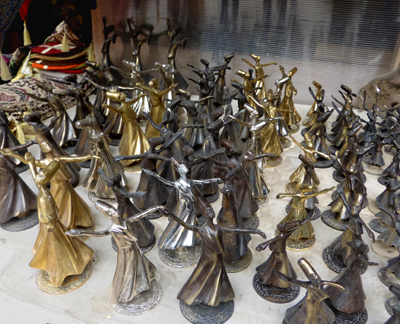
A whirling brass souvenir you can buy all over Türkey
In 2007 Unesco added
the sema to it's list of protected conceptual cultural heritage. |
|
mukti4u2@gmail.com |
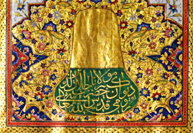 |
www.mukti4u2.dk |
mukti4u2.dk
►
created by
BP |